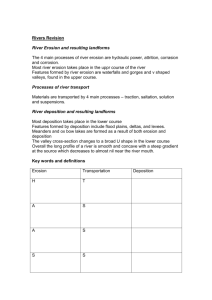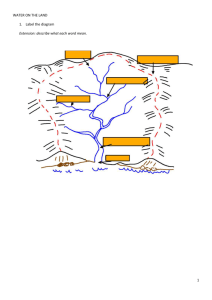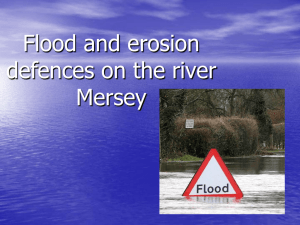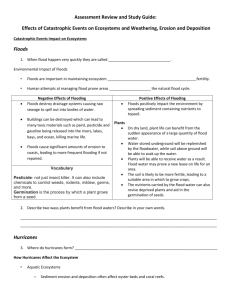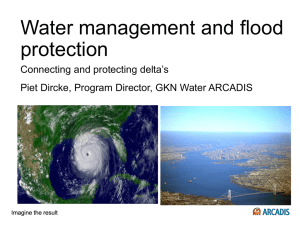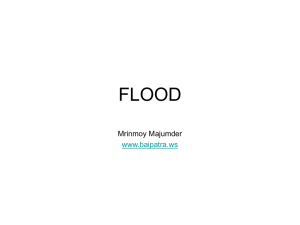Rivers Revision
advertisement
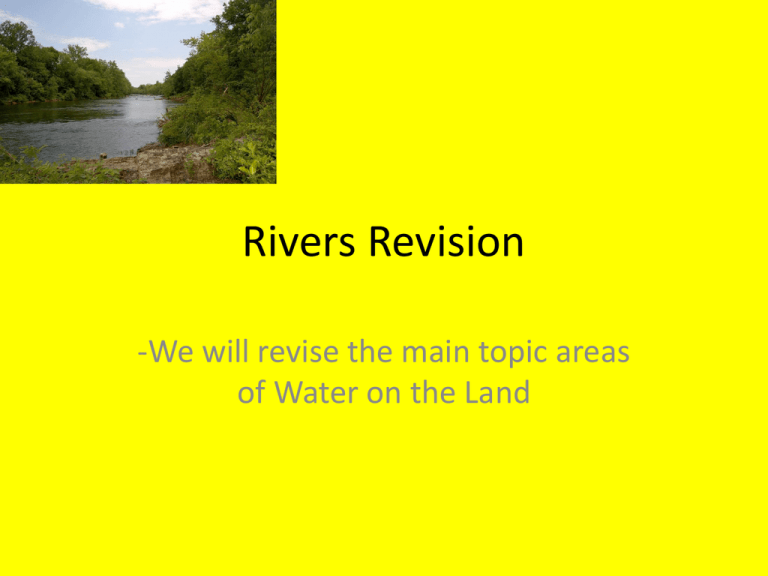
Rivers Revision -We will revise the main topic areas of Water on the Land Knowledge Checklist • • • • • • • • • Know the processes of erosion Know the processes of transportation Know how waterfalls and gorges are formed Know how meanders and ox-bow lakes are formed Know how flood plains and levees are formed Know the factors that affect river discharge Know the physical and human causes of flooding Know a case study of a rich and poor country flood Know how hard and soft engineering can be used in flood management • Know how water is used in the UK with areas of surplus and deficit • Know a case study of a reservoir in the UK The Profile of a River Key Idea: The shape of river valleys changes as rivers flow downstream due to the dominance of different processes. Processes of erosion – hydraulic action, abrasion, attrition, solution; vertical and lateral erosion. Processes of transportation – traction, saltation, suspension and solution. Deposition and reasons for it. Long profile and changing cross profile. The Water Cycle It is the main input to the drainage basin The long profile and the drainage basin • • • The long profile of a river is a cross section from its source to its mouth. This whole area is known as the drainage basin. They are divided into three sections: – Upper course – Middle course – Lower course River gradient decreases gradually as the river flows downstream (ie. It becomes less steep) Drainage Basin Key words • A river basin is the area of land drained by a river and its tributaries • Watershed – an area of higher land separating two drainage basins • Source – the place where a river begins • Tributary – a smaller river joining a larger one • Confluence – the place where two rivers join • Mouth – the place where a river enters a lake or the sea Processes of Erosion Transportation • • • • • Material is carried in the river in four ways: Traction: large stones are rolled along the river bed Saltation: smaller stones ‘bounce’ along the river bed Suspension: small particles of silt and clay float through the water Solution: minerals are dissolved in the river Deposition Deposition is the dumping of material and happens when the river loses its energy. This may be during a dry spell, on the inside of a river bend, or when the river reaches the sea (read on for more on this). The Long Profile of a River L.Ob: to describe how a river changes from source to mouth Think about the 2 pictures of rivers: why are they so different? Features at the 3 stages of a river Why? UPPER COURSE SOURCE MIDDLE COURSE Lateral & vertical erosion, transportation, deposition LOWER COURSE Transportation & deposition Vertical erosion & transportation MOUTH V-shaped valley Waterfalls Rapids Interlocking spurs Meanders Ox-bow lakes Levees Flood plain SEA River Severn – Source to Mouth Video Upper Course • • • • Vertical erosion is the main process. Valleys are v-shaped, interlocking spurs. Waterfalls are formed. Rapids are smaller scale feature formed where finer bands of varying resistance of rocks are found. Foundation Question Higher Question Upper Course – V-Shaped Valleys and Interlocking Spurs Upper Section Landforms Waterfalls • • 1. 2. 3. 4. 5. A waterfall is a place on a river where the water flows vertically They tend to occur in the upper course of a river Softer rock erodes quickly, undercutting harder rock Harder rock erodes more slowly, forming overhang Overhang eventually collapses – the waterfall moves upstream Steep sided valley (gorge) is formed Plunge pool erodes under waterfall Landforms in Middle and Lower Sections: Meanders Formation of Meanders Slow flow = loss of energy. Fast flow = lots of energy. Low energy = deposition. High energy=erosion Foundation and Higher Question Meanders and Ox-Bow Lakes Meandering stream flowing from top of screen to bottom Maximum deposition Maximum erosion Meander scars Oxbow Lake Oxbow cuttoff Foundation Question Higher Question A Delta Some rivers reach the sea in deltas, which form where river mouths become choked with sediment, causing the main river channel to split into hundreds of smaller channels or distributaries Deltas only form under certain conditions • The river must be transporting a large amount of sediment • The sea must have a small tidal range and weak currents • The sea must be shallow at the river mouth Famous deltas consist of the Mississippi delta, The Ganges and Brahmaputra delta (Bangladesh) and of course the Nile delta. Flood Plains and Levees When a river continually floods, it spreads silt across the flood plain. Often this material piles up to form levees. Sometimes, humans make artificial levees to mimimise the impact of flooding. Peak Rainfall Peak Discharge Flood Hydrograph RAINFALL mm DISCHARGE (cumecs) LAG TIME time River DISCHARGE • Discharge is the volume rate of water flow, which is transported through the river channel. • Measured in cumecs (cubic metres per second) The Flood Hydrograph – A = floods quickly (flash flood) B = slower rate of discharge, less likely to flood WHAT FACTORS AFFECT THE DISCHARGE LINE? Factors Affecting Water in a River • • • • • • Amount and type of rainfall Previous weather conditions Land use Temperature Rock type Relief Describe 5 factors that might affect the lag time (time it takes river to flood) Describe 5 factors that might affect the lag time (time it takes river to flood) • • • • • 1 = Deforestation 2 = Urbanisation 3 = Relief of land 4 = Dam Building 5 = Industry/Agriculture Contrast the hydrographs (3) Explain why the two hydrographs are different (4) Foundation Higher Flooding Physical Factors Human Factors Prolonged Rainfall Deforestation Snowmelt Impermeable materials Heavy Rainfall Relief Frequency of Flooding Flooding in the UK appears to be happening more often! Case Studies • You need to know too flood case studies! – Rich Country (Worcestershire, England) – Poor Country (Bangladesh) MEDC: UK Floods 2007 Write a quick case study…. What caused the floods? What were the main effects? What are the solutions? FLOODING IN AN LEDC – Bangladesh Case Study IMPORTANT DATES and DEVELOPMENT INDICATORS for Bangladesh CAUSES of the flood: MANAGEMENT RESPONSES – can they reduce the impact?: EFFECTS of the flood on People and Environment: Remember SHORT and LONG TERM Hard Vs Soft Engineering Page 92 of book Raise levees Dredge river beds Straighten rivers Hard Vs Soft Engineering Zone off some areas Better warning systems Model answers and mark scheme For more past papers and info visit the OCR ‘A’ Geography website http://www.ocr.org.uk/qualifications/gcse/geography_a/documents.html Managing Water in the UK • What causes the water stress? • How can we be more efficient with water? (6) Reservoir Case Study • You need to know one case study of a reservoir that provides water to people in the UK Kielder Reservoir is in book - Biggests man-made reservoir in Europe. - Was poor farmland, large valley with steep sides. - Lots of rainfall and low population. - Wild habitats were limited so little environmental damage. - Supplies NE of England wit water. - Lots of leisure industry there. Good for economy. Past Paper Questions Click for examiners mark scheme Model answers and mark scheme Continues….. Model answers and mark scheme Continues…..
